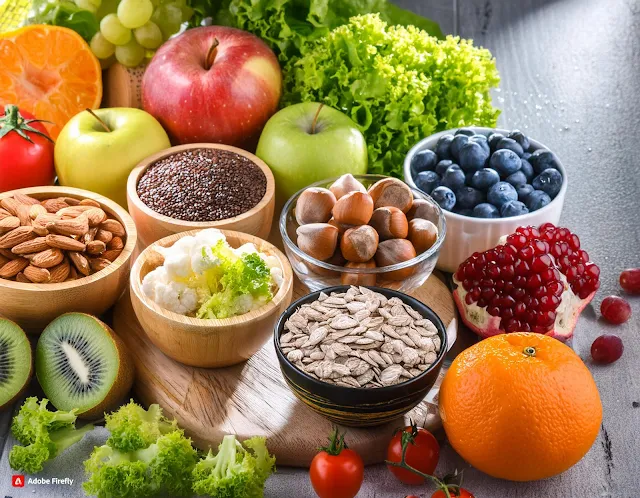High Fiber Foods | Fiber Rich Foods | Fiber Rich Fruits & Vegetable
Introduction To High Fiber Foods
Fiber is a type of carbohydrate found in plant-based foods. Unlike other carbohydrates such as sugar and starch, fiber is not digested by the human body. Instead, it passes through the digestive system virtually intact, providing many health benefits.
Fiber plays an important role in maintaining a healthy digestive system, regulating bowel movements, and ensuring a feeling of fullness after meals. Additionally, it may lower cholesterol and reduce the risk of certain chronic diseases, making it an important nutrient for overall health.
Types Of Fibers
A. Water Soluble Dietary Fiber
1. Benefits Of Soluble Dietary Fiber
B. Insoluble Dietary Fiber
Insoluble fiber does not dissolve in water and passes through the digestive system relatively unchanged. Increases stool volume, promotes stool regularity, and prevents constipation.
1. Benefits Of Insoluble Dietary Fiber
Insoluble fiber, found in foods such as whole grains, nuts, and vegetables, helps maintain a healthy digestive system by preventing constipation and promoting healthy bowel function.
Health Benefits Of High Fiber Foods
A. Digestive health
1. Prevention Of Constipation
B. Weight management
1. Provide Saturation
Fiber-rich foods take longer to digest, making you feel fuller for longer. Dietary fiber helps prevent overeating by increasing satiety and supports weight management efforts.
C. Heart Health
1. Lower Cholesterol Levels
List Of Foods Rich In Dietary Fiber
A. Fruit Rich In Fiber
B. Vegetables Rich In Dietary Fiber
 |
| High Fiber Foods |
Include Fiber-Rich Foods In Your Diet
A. Meal planning
B. Snack Options
Potential Risks And Considerations
A. Increased Fiber And Gas Consumption
b. Hydration And Dietary Fiber Intake
Fiber absorbs water as it passes through your digestive tract, so staying hydrated is essential when increasing your fiber intake. Be sure to drink plenty of water throughout the day to maintain healthy digestion.
Conclusion
Incorporating high fiber foods into your diet is a simple and effective way to boost your health and well-being. From supporting digestive health to promoting heart health and aiding in weight management, fiber offers a multitude of benefits that can help you look and feel your best. So why wait? Start incorporating fiber-rich foods into your meals today and experience the difference firsthand.
Take A Look At Frequently Asked Questions [FAQs]
A1 : The recommended daily intake of fiber varies depending on factors such as age, gender, and overall health. However, most adults should aim for around 25 to 30 grams of fiber per day.
Q2 : Can I get enough fiber from supplements alone?
A2 : While fiber supplements can be convenient, it's best to obtain fiber from whole foods whenever possible. Whole foods provide not only fiber but also essential vitamins, minerals, and other nutrients that are beneficial for overall health. Supplements should be used as a complement to a healthy diet, rather than a replacement for whole foods.
Q3 : Are there any specific high fiber foods that I should avoid?
A3 : While most high fiber foods are beneficial for health, some individuals may need to avoid certain types of fiber-rich foods due to digestive issues or food sensitivities. For example, those with irritable bowel syndrome (IBS) may need to limit their intake of certain types of fiber, such as insoluble fiber found in bran and raw vegetables, as these can exacerbate symptoms. It's essential to listen to your body and adjust your diet accordingly.
Q4 : How can I tell if I'm getting enough fiber in my diet?
A4 : Pay attention to your body's signals. If you're experiencing regular bowel movements, feeling full and satisfied after meals, and maintaining a healthy weight, chances are you're getting enough fiber. However, if you're experiencing constipation, bloating, or other digestive issues, it may be a sign that you need to increase your fiber intake.
Q5 : Can children benefit from a high fiber diet?
A5 : Absolutely! A diet rich in fiber is beneficial for people of all ages, including children. Fiber plays a crucial role in supporting digestive health, regulating bowel movements, and promoting overall well-being. Encourage children to eat a variety of fiber-rich foods, such as fruits, vegetables, whole grains, and legumes, to ensure they receive adequate nutrition for growth and development.
Remember, incorporating high fiber foods into your diet doesn't have to be complicated. Start by making small changes, such as swapping refined grains for whole grains, adding fruits and vegetables to your meals, and choosing fiber-rich snacks. Over time, these simple adjustments can add up to significant improvements in your health and vitality. So why wait? Take the first step towards a healthier lifestyle today by embracing the power of fiber-rich foods.


Comments
Post a Comment